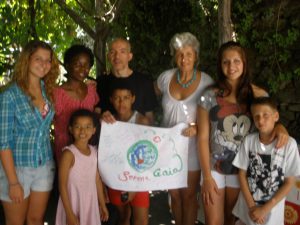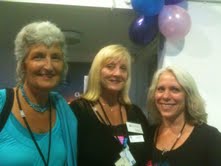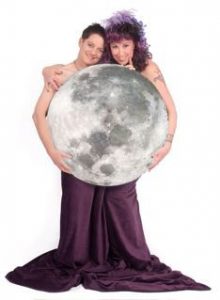“Bisexuality, Gaia, Eros: Portals to the Arts of Loving”
BiReCon Proceedings: A forthcoming issue of The Journal of Bisexuality
“Bisexuality, Gaia, Eros: Portals to the Arts of Loving”
BiReCon Proceedings: A forthcoming issue of The Journal of Bisexuality
BiReCon Proceedings: A forthcoming issue of The Journal of Bisexuality
So the idea of a portal seemed fine. It would open new horizons. It would resonate with the work of Robyn Ochs, another keynote speaker, whose book, Getting Bi, registers voices of bi people across the planet. Yet it felt a bit off and perhaps not quite in tune with what was out there in the melee of early third-millennium bisexual life. After all, I came out in the early 1990s, I’ve organized my personal and professional life largely around bisexuality, and I’ve had plenty of time to select extraneous influxes out of it. Attendance in BiReCon and BiCon combined provided a unique standpoint to get the pulse of where bisexuality is at in a variety of geo-cultural locations and from the multiple perspectives of research, scholarship, theory, creative expression, advocacy, and community building. (For insights on those dynamics I refer readers to “BiReCon,” in this volume, a contribution by the organizers.) The context was perfect for producing knowledge in action. At the time of this writing, I’ve had a chance to reflect on my own keynote remarks, on the experience of participating in the two events combined, and the process of creating the present volume from contributions thereof. I choose this as an opportunity to offer the wisdom of what I learned in the process, along with a written elaboration of my keynote remarks.
BiReCon Proceedings: A forthcoming issue of The Journal of Bisexuality
Acknowledgement: This piece is pre-published here with permission of Routledge, New York, a division of Taylor and Francis.
BiReCon Proceedings: A forthcoming issue of The Journal of Bisexuality
When people like you decide what a best seller looks, feels, reads like, we can transform the publishing industry into one that really reflects the creative intelligence of readers. When you decide to participate in this push, you also create better book-contract opportunities for writers whose creative intelligence resonates with your ideas, ideals. This book has been described both as a ‘disgrace’ and as a ‘masterpiece.’ It has made waves of differing opinions in its own niche communities. The author has issued a ‘clarification statement’ in response to these. Don’t you wish to know what this is all about immediately? Well . . . . yes, you do, but please mark your calendar for the 26th and on that day click on the book-cover image.
We at 3WayKiss wish to thank you from a deep place in our heart. We are a non-profit based in Puerto Rico devoted to the mission of “educating the public world wide about the arts of loving and their infinite forms of expression that our species make piece with our gracious hostess, the third planet Gaia.” We could not be more thrilled to reach out with this special offer to you!
If you are not familiar with digital book reading, this is a good time to start. Download the free software Kindle for PC, or another free software for mobile devices. What a great, ‘right livelihood’ way to read. No more paper, no more trees! No more storing, dusting, shipping, logging around those heavy, expensive print books. All the intensity, complexity, reliability, in-depth knowledge a book can offer, for the feather weight of a digital file stored on your hard disk!
 |
| Teaching Gaia in Greece |
 |
| With Regina Reinhardt and Robyn Ochs in London for BiReCon |
 |
| Annie Sprinkle – Wedding to the Moon |
What a relief for those of us aspiring to a light footprint. And how consonant with the whole idea of Gaia as the basis for a new, ecosexual politics of love! Start building your digital library on the 26th!
The author’s summer has been fabulous with new travels and experiences, including seminars on The Wisdom of Love in the San Francisco Bay Area with such avatars of Polyamory as Deborah Taj Anapol and Dossie Easton; teaching compersion, polyamory, and Gaia theory in Washington State and Greece; coaching participants ready to design the amorous life of their dreams; visiting oracle shrines in Greece and naturist villages in France, and keynoting at BiReCon the Bisexuality Research Conference in England.
Now she’s ready for more, with participation in Annie and Beth’s Wedding to the Moon ecosexual performance and symposium in LA, October 23-24, with workshops and readings planned for the 16 and the 19, more workshops on Managing Jealousy in November in Puerto Rico, and more events to be announced.
With deep appreciation for your interest and business, we at 3WayKiss remain yours truly, in devotion and ecosexual friendship.
Namaste,
Serena Anderlini @ 3WayKiss
author of Gaia and the New Politics of Love, a Silver Winner for Cosmology and New Science for the 2010 Nautilus Book Awards, and many other fabulous books
Professor of Humanities at the University of Puerto Rico, Mayaguez
This argument started with Bachofen, in the late 19th-early20th century, who, in Myth, Religion and Mother Right, argued that matriarchal social organizations were prevalent throughout the Neolithic for that precise reason: that paternity was not a concept yet, and so men did not think they should know who put the seed in. Women were more revered and also more free: they had sex with multiple partners, especially in the fertile period, to make sure someone would make them pregnant.
This line of thought developed further with feminist philosophers and theorists of the ‘second wave,’ including, to my knowledge, Adriana Cavarero, who, in In Spite of Plato (translated by yours truly), argues that this ignorance of paternity was a good thing, because it empowered women with sovereignty over our bodies, and the decision to be hostesses to the reproductive process necessary for the species was ours and ours alone. Two other theorists on this topic are of course Riane Eisler and Marija Gimbutas. Eisler links the social practice of competition to the social construct of paternity and the ensuing practice of controlling the female body that hosts the seed to ensue its authenticity, the fact that the resulting child is sired by the man who parents it. This, Eisler observes, not only disempowers women, but also preempts the possibility of a society organized on partnership. Because partnership requires trust and equality, and these are impossible when men’s self esteem is predicated on their ability to certify paternity. Matrifocal societies are better candidates for partnership systems. The Romans, who learned a lot from the Greeks, and the matrifocal cultures that preceded them, put this very simply: “maternity is always certain, paternity never is.” So, if it isn’t, let’s shift our focus away from it, argues Gimbutas, who studies the matrifocal cultures of the Neolithic in the pre-Indoeuropean Mediterranean, to find out that they indeed were organized around the sacred feminine, myths of fertility, the management of waters, the practice of sharing resources, including amorous, sexual,and reproductive resources, the commons, and social peace. social peace.
More to the point, this new acquaintance with polyamory as a natural, biologically-programmed, and long-standing prevalent tradition that goes back all the way to pre-history is a way to revisit the past to invent a new future. If something was done in pre-historical times we often consider it bad, backward, ‘primitive.’ But what is ‘bad’ about primitivism? What we often call ‘history’ is actually a very short period in the life of our species. A well documented one, for sure! But a ‘good’ one? The past ten thousand years have been filled with wars, empires, exterminations, genocides, tortures, competitions, extinctions and other forms of destructive behavior that we humans have inflicted on fellow creatures and a whole bunch of other species, not to mention entire habitats, climate and ecosystems, based on ever more powerful weapons and domination systems that have, ultimately, had the effect to make us, the inventor species, also a rather unhappy species, with very few individuals still able to connect with the magic of nature, the ability to contemplate existence in the present as a state of pure bliss.
Maybe those matrifocal ‘primitives’ who knew nothing about paternity, and were ‘naturally’ polyamorous because they loved nature in all its manifestations, including several people, were happier than today’s average person. So, by finding out how these poly primitives lived, by looking at the origins of sexuality in the long-standing life of our species, we can also come to a better understanding of a different time in our ‘history,’ a time when ‘history’ was actually more of a ‘herstory,’ as fellow second-wave feminists Susan Griffin and others would put it.
This will help us also dispell another myth: that women naturally ‘suffer’ polyamory while men are the ones who want it. Really? How come today’s women would ‘naturally’ demand monogamy when historically the times when polyamory was natural are times when women were revered, sovereign, and free? If paternity, the cultural construct of male insemination as ’cause’ of female fertility, is what caused dominant societies where women lost that sovereignty and that freedom, then perhaps sexual exclusivity is a result of patriarchal social organizations too?
An ecosexual future is also a Gaian future, a future when the fact that our planet Gaia is gay will finally be recognized by our sad and ingeniously destructive and self-destructive species and when we will decide to use our ingenuity to finally keep Gaia gay too.